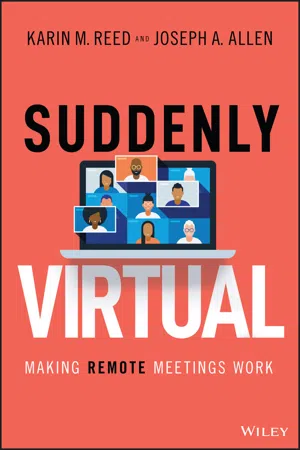
- English
- ePUB (mobile friendly)
- Available on iOS & Android
About This Book
Supercharge your virtual meetings with evidence-based practices from an award-winning team
The shift to virtual meetings was sudden and often traumatic for businesses across all industries as they responded to the global pandemic. Rather than focusing on what worked best, they focused on what worked now... which meant closing up the office and being suddenly virtual in nearly every meeting, often without the tools, the training, or the expertise to optimize the new "kitchen table" office. Thankfully, businesses are beginning to be more purposeful in both the tools they use and the approach they take.
This book seeks to be a definitive guide for businesses looking to make their meetings as effective as possible in the ever-evolving "new normal"—leveraging insights from some of the foremost thought leaders in meeting science and on-camera communication.
This book will:
· Highlight new research insights springing from the rapid and exponential adoption of virtual meeting technology
· Discuss the problems, challenges, and pitfalls of meeting in this new modality
· Provide practical, actionable best practices, backed by meeting research that lead to more productive and effective virtual meetings
Perfect for executives, managers, and employees at companies in all industries and of all sizes, Suddenly Virtual provides practical and actionable best practices that lead to more productive and effective remote meetings.
Frequently asked questions
PART ONE
Our New Virtual Reality – A Suddenly Remote Workforce
CHAPTER 1
What Happened to Meetings?: The Meeting Scientist Perspective
- The sequence of events that led to much of the world of work going remote.
- The rise of the virtual meeting.
- How businesses scrambled to adapt to the new virtual reality.
How Did We Get Here?
| Timeline of Events from the COVID‐19 Pandemic (Kantis, Kiernan, and Bardi 2020) | |
| December 8, 2019 | A patient in the city of Wuhan sought medical help for pneumonia‐like symptoms. |
| January 3, 2020 | China officially notifies the WHO of an outbreak. |
| January 21, 2020 | United States confirms its first case in Washington state, a man who traveled to the Wuhan area. |
| January 23, 2020 | WHO meets again and decides not to declare the outbreak a Public Health Emergency of International Concern (PHEIC). |
| January 24, 2020 | Nepal, Vietnam, France, and Malaysia confirm their first cases. Wuhan construction crews are working on two hospitals to treat patients of the outbreak: the first is to be completed on February 3 and the second in early February. |
| February 4, 2020 | The U.S. Food and Drug Administration issues an emergency use authorization for CDC's diagnostic test. President Trump pledges to safeguard Americans from the coronavirus in his State of the Union address. |
| February 7, 2020 | Total Cases Confirmed Globally: 31,484. |
| February 10, 2020 | The United Kingdom declares that the coronavirus constitutes a serious and imminent threat to public health. The Trump administration releases a budget proposal for FY21 that would sharply cut funding for WHO and global health funding. |
| February 13, 2020 | U.S. CDC Director says that the coronavirus will likely become a community virus and remain beyond this season. |
| February 15, 2020 | The United States announces plans to evacuate nearly four hundred Americans quarantined on the Diamond Princess cruise ship; passengers who test positive for COVID‐19 will be treated in Japan. |
| February 25, 2020 | U.S. CDC warns that spread to the United States is likely and that people should prepare. |
| February 29, 2020 | Australia reports its first death, an evacuee from the Diamond Princess. The United States reports its first death, a man in his fifties with an underlying health condition. Washington state declares a state of emergency. |
| March 7, 2020 | Roughly 5,861 coronavirus tests are completed by CDC and public health labs in the United States. New York declares a state of emergency. |
| March 11, 2020 | WHO declares the coronavirus outbreak a pandemic. Washington, D.C., declares a state of emergency. United States announces level 3 travel advisory and suspends entry to all foreign nationals traveling from China, Iran, and certain European countries at any point during the 14 days prior to their scheduled travel to the U.S. NBA suspends their season. Italy closes all shops and venues across the country. The United Nations reports that about 20% of students are out of school globally as a result of the pandemic. |
| March 12, 2020 | U.S. stocks record their worst day since 1987. New York City declares a state of emergency. Ohio closes all public schools until at least April 3, 2020. France closes all schools. Virginia declares a state of emergency. |
Table of contents
- Cover
- Table of Contents
- Title Page
- Copyright
- Dedication
- Preface: The Collision and Convergence of Two Areas of Expertise
- Acknowledgments
- PART ONE: Our New Virtual Reality – A Suddenly Remote Workforce
- PART TWO: The Science of Meetings
- PART THREE: The Benefits and Challenges of Video Communication
- PART FOUR: The Biggest Opportunities and Challenges of Virtual Meetings
- PART FIVE: What's Next in the Suddenly Virtual Meeting World?
- Conclusion: Our Own Remote Work Experiment
- About the Authors
- Index
- End User License Agreement